Services on Demand
Article
Indicators
Related links
-
 Cited by Google
Cited by Google -
 Similars in Google
Similars in Google
Share
South African Journal of Animal Science
On-line version ISSN 2221-4062
Print version ISSN 0375-1589
S. Afr. j. anim. sci. vol.34 n.5 Pretoria 2004
Antibiotic residue withdrawal periods in milk of Saanen dairy goats and udder tissue irritation: Preliminary results
J. KarzisI, #; E.F. DonkinII; I.M. PetzerI
IDepartment of Production Animal Studies, Faculty of Veterinary Science, University of Pretoria, Private Bag X04, Onderstepoort 0110, South Africa
IIDepartment of Animal & Wildlife Sciences, Faculty of Natural & Agricultural Sciences, University of Pretoria 0002, South Africa
ABSTRACT
Antibiotic residues in goat milk were measured in two trials. In Trial 1, eight goats were treated with Curaclox LC and six goats were untreated controls. All goats were in early lactation except for one. Withdrawal periods of Curaclox LC calculated according to the Thermo-Resistant Inhibitory Substances (TRIS) test were shorter than withdrawal periods corresponding to the disappearance of the blue dye in the milk. Somatic cell counts (SCC) of treatment and control groups peaked after treatment and returned to baseline. The SCC of non-infected goats was slightly lower than those of infected goats. In Trial 2, seven goats were treated with Spectrazol and seven goats were untreated controls. All goats were in mid to late lactation. Withdrawal periods calculated according to TRIS results in Trial 2 were longer than those of Trial 1. The SCC of treatment and control group and of infected and non-infected goats remained unstable in Trial 2, due to late lactation and stress.
Keywords: Goat milk, antibiotic withdrawal
Introduction
Dairy goats rather than cows are often more appropriate for subsistence milk production (Devendra & Burns, 1983; Donkin, 1997). Mastitis can be a major disease in dairy goat production (Higgs & Bramley, 1980; Jackson, 1980; Fisberg et al., 2000). Limited research has shown that withdrawal times for antibiotic residues are longer in goat milk than in milk from cows (Debackere, 1995; Al-Bassan & Hasso, 1996). Antibiotic residues in goat milk may cause anaphylactic and allergic reactions in humans consuming the milk, cause the development of resistant strains of bacteria and affect the cheese-making process (Stabenfeldt & Spencer, 1965; Youzhang, 1996).
Materials and Methods
A semi-synthetic penicillin-based intramammary preparation (Curaclox LC, containing 75 mg sodium ampicillin and 200 mg sodium cloxacillin per dose plus blue dye) was administered into both udder halves of eight goats. Six similar goats were used as untreated controls.
Milk production of each goat was measured 12 hourly. Foremilk samples were taken and tested for conductivity and California Milk Cell Test (CMCT). Results of the first three samplings were used to determine a baseline. On the fourth sampling, the goats were given antibiotic for three treatments at 12 hourly intervals. Milk samples were analyzed until there were no antibiotic residues present, as indicated by the results of the Thermo-Resistant Inhibitory Substances (TRIS) test and when the somatic cell counts (SCC; Fossomatic 90) had returned to that of the baseline. Culturing onto BTA plates identified bacteria. The trial was repeated using a cefuroxime 250 mg based intramammary product (Spectrazol Milking Cow, Schering-Plough). Seven goats were treated and the remaining seven goats were used as controls.
Results
Figure 1 and Figure 2 illustrate the results of Trial 1, in which all the goats were in early lactation, except for goat number 9/2, which was in late lactation. Both Figures 1 and 2 illustrate a sudden increase in cell counts the first evening the goats were sampled, probably due to the stress of the change in the usual milking routine. However by the next morning, the SCC had dropped to baseline. The goats were treated with Curaclox LC on the evening of the first treatment. Subsequent treatments were given on the morning and evening of the following day. The SCC peaked after all three antibiotic treatments had been administered. Four days later SCC had returned to baseline, indicating the end of udder irritation caused by antibiotics administered to the udder.
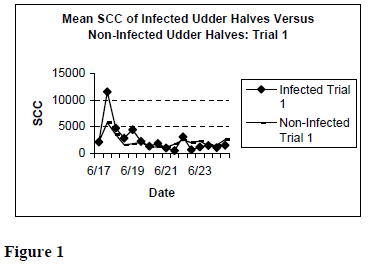
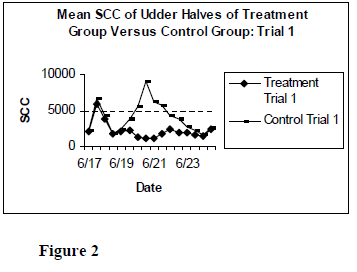
The SCC of infected and non-infected udder halves remained within the same range after the initial rise in SCC on the first evening, which dropped to baseline by the next morning. Figure 3 and Figure 4 illustrate the results of Trial 2 when all the goats used were in mid to late lactation. The SCC of the treatment group at the start was higher than that of the control group and remained higher throughout the trial, except when it was lower than that of the control group on two days (Fig. 3). The SCC of the control group remained unstable throughout the trial. The rise and fall of the SCC of Figure 3 did not correspond to the administration of Spectrazol.
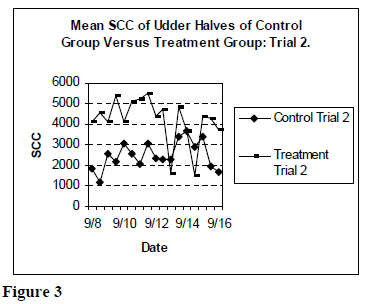
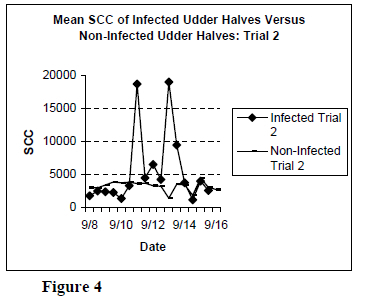
The SCC of the non-infected udder halves started at a higher point than the SCC of the infected udder halves (Fig. 4). SCC of infected udder halves remained unstable throughout the trial and did not correspond to administration of Spectrazol treatments.
Withdrawal periods for Trial 1 (Curaclox LC) calculated according to the TRIS results ranged from 3 days (72 h) to 4.5 days (108 h). The withdrawal periods for Trial 1 calculated according to the disappearance of the blue dye ranged from 3.5 days (84 h) to 5.5 days (132 h). Withdrawal periods for Trial 2 (Spectrazol) calculated according to the TRIS results ranged from 3.5 days (84 h) to 5.5 days (132 h).
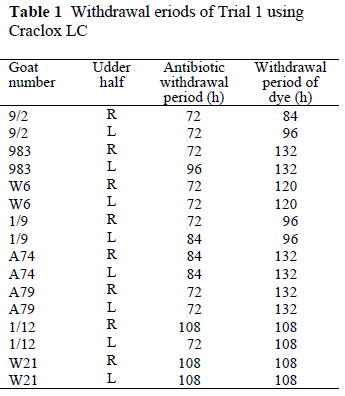
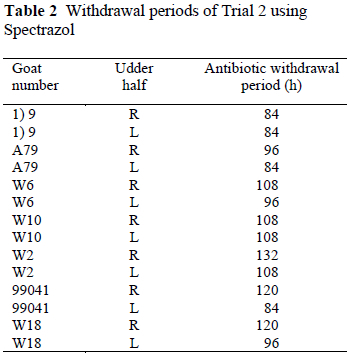
Discussion
The fluctuation of results in Trial 2, as illustrated in Figure 3 and Figure 4, could have been due to the late lactation cycle of the goats or due to stress. During this trial the dairy experienced fluctuations in the electricity supply causing the milking machine to stop and start irregularly during milking, thus increasing udder-irritation and stress and resulting in increased and irregular SCC.
In Trial 1 using Curaclox LC, the withdrawal periods calculated according to TRIS test (showing no inhibition from antibiotic residues) were shorter than the withdrawal periods indicated by the disappearing of the blue dye in the milk. Thus according to this trial this product may be successfully used for treatment of mastitis in goats, since the withdrawal times of the antibiotic residues were shorter than the indication of the dye. In Trial 1 all the goats were in early lactation except for goat number 9/2.
In Trial 2 Spectrazol was used and all the goats used were in mid to late lactation. The withdrawal periods for Spectrazol were longer than those for Curaclox LC. However, this could also have been caused by the later stage of lactation and the stress on the goats and not be a true indicator that Spectrazol had a longer withdrawal period of antibiotic residues than Curaclox LC.
Conclusion
Withdrawal periods according to dye disappearance indicated that Curaclox LC may be used on goats and that the milk was safe for human consumption when the dye had disappeared. Withdrawal periods as indicated by TRIS were longer for Spectrazol than for Curaclox LC. The maximum withdrawal periods required for goats as shown by this experiment were longer than those given according to the directions for use in cattle. These were stated to be 60 h for Spectrazol and 72 h for Curaclox LC in cows. This was a preliminary study and more data have to be collected in order for statistically viable results to be obtained to substantiate the above statements.
References
AL-Bassan, L.S. & Hasso., 1996. S.A. Mastitis in goats caused by Nocardia asteroids. Proc. 6th Int. Conf. on Goats, Beijing, China. Volume 2. pp. 758-760. [ Links ]
Debackere, M., 1995.Pharmacokinetics and pharmacodynamics of antimicrobials in relation to their residues in milk. Proceedings of Symposium on Residues of Antimicrobial Drugs and other Inhibitors in Milk. Kiel, Germany. pp. 41-77. [ Links ]
Devendra, C. & Burns. M., 1983. Goat production in the Tropics. Commonwealth Agricultural Bureaux, Slough, England. pp. 184-190. [ Links ]
Donkin, E.F., 1997. Productivity and diseases of Saanen, Indigenous and Crossbred goats on zero grazing. PhD Thesis, Faculty of Veterinary Science, Medical University of Southern Africa. [http://upetd.up.ac.za/thesis/available/etd-07252003-155054/]. [ Links ]
Fisberg, M., Ferreira, A.M.A., Nogueira, M. & Fisberg, R.M., 2000. Acceptance and tolerability of goat milk in preschool children. Proc. 7th Int. Conf. on Goats, Tours, France. pp. 881-883. [ Links ]
Higgs, T.M. & Bramley, A.J., 1980. Laboratory techniques for the examination of milk samples. Mastitis Control and Herd Management. Technical Bulletin 4. Proceedings of a Course organized by the National Institute for Research in Dairying, for the British Cattle Veterinary Association. pp. 95-100. [ Links ]
Jackson, E.R., 1980. The role of the veterinary practitioner in mastitis control. Mastitis Control and Herd Management. Technical Bulletin 4. Proceedings of a Course organized by the National Institute for Research in Dairying, for the British Cattle Veterinary Association. pp. 253-255. [ Links ]
Youzang, Z., 1996. Goat Industry and its significance in Chinese Economy. Proc. 6th Int. Conf. on Goats, Beijing, China. Volume 1, p. 1. [ Links ]
# Corresponding author. E-mail: joanne.karzis@op.up.ac.za














